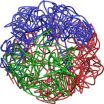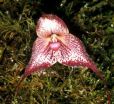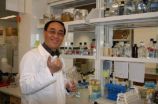(Press-News.org) If there is one thing that recent advances in genomics have revealed, it is that our genes are interrelated, "chattering" to each other across separate chromosomes and vast stretches of DNA. According to researchers at The Wistar Institute, many of these complex associations may be explained in part by the three-dimensional structure of the entire genome. A given cell's DNA spends most of its active lifetime in a tangled clump of chromosomes, which positions groups of related genes near to each other and exposes them to the cell's gene-controlling machinery. This structure, the researchers say, is not merely the shape of the genome, but also a key to how it works.
Their study, published online as a featured article in the journal Nucleic Acids Research, is the first to combine microscopy with advanced genomic sequencing techniques, enabling researchers to literally see gene interactions. It is also the first to determine the three-dimensional structure of the fission yeast genome, S. pombe. Applying this technique to the human genome may provide both scientists and physicians a whole new framework from which to better understand genes and disease, the researchers say.
"People are familiar with the X-shapes our chromosomes form during cell division, but what they may not realize is that DNA only spends a relatively small amount of time in that conformation," said Ken-ichi Noma, Ph.D., an assistant professor in Wistar's Gene Expression and Regulation program and senior author of the study. "Chromosomes spend the majority of their time clumped together in these large, non-random structures, and I believe these shapes reflect various nuclear processes such as transcription."
To map both individual genes and the overall structure of the genome, Noma and his colleagues combined next generation DNA sequencing with a technique called chromosome conformation capture (3C). They then used fluorescent probes to pinpoint the exact location of specific genes through a microscope. With these data, the researchers were able to create detailed three-dimensional computer models of the yeast genome.
Using this novel approach, the researchers can view genes as they interact with each other. Noma and his colleagues can view where highly active genes are located, or see if genes that are turned on and off together also reside near each other in the three-dimensional structure of the genome. In total, the Wistar researchers also studied 465 so-called gene ontology groups – groups of genes that share a related purpose in the cell, such as structure or metabolism.
"When the chromosomes come together, they fold into positions that bring genes from different chromosomes near each other," Noma said. "This positioning allows the processes that dictate how and when genes are read to operate efficiently on multiple genes at once."
This structure is not merely an accident of chemical attractions within and among the chromosomes – although that is certainly a part of the larger whole – but an arrangement guided by other molecules in the cell to create a mega-structure that dictates genetic function, Noma says. He envisions a scenario where accessory molecules, such as gene-promoting transcription factors, bind to DNA and contribute to the ultimate structure of the genome as the chromosomes fold together.
"I believe we are looking at a new way to visualize both the genome itself and the movements of all the various molecules that act on the genome," Noma said.
According to the Wistar scientists, their techniques are scalable to the human genome, even though fission yeast only has three chromosomes. In fact, the researchers found signs of "transcription factories" – clusters of related genes that are read, or "transcribed," at discrete sites – which have been proposed to exist in mammals.
INFORMATION:
This study was funded through a National Institutes of Health Director's New Innovator Award.
Co-authors of this study include post-doctoral researchers Hideki Tanizawa, Ph.D., Osamu Iwasaki, Ph.D., and Atsunari Tanaka, Ph.D., and Research Assistant Joseph R. Capizzi, who are all members of the Noma laboratory. They worked in collaboration with Priyankara Wickramasinghe, Ph.D., Mihee Lee, Ph.D., and Zhiyan Fu, Ph.D., of Wistar's Bioinformatics Facility.
Is the shape of a genome as important as its content?
Study shows structure exposes genes to regulation and chromosomal crosstalk
2010-10-30
ELSE PRESS RELEASES FROM THIS DATE:
Scientists seek urgent treatment for fatal sleeping sickness
2010-10-30
Urgently-needed new treatment for a parasitic disease is being investigated in research led at the University of Strathclyde in Glasgow, Scotland.
Human African Trypanosomiasis, also known as sleeping sickness, affects between 50,000 and 70,000 people in Africa and South America. It is transmitted through the bite of the tsetse fly and attacks the nervous system and brain, leading to fever, headaches and disturbed sleep patterns.
Without treatment, the disease is fatal but a new drug to tackle it is being developed in a project led at Strathclyde, with partners from ...
Raising giant insects to unravel ancient oxygen
2010-10-30
Boulder, CO, USA - The giant dragonflies of ancient Earth with wingspans of up to 70 centimeters (28 inches) are generally attributed to higher oxygen atmospheric levels in the atmosphere in the past. New experiments in raising modern insects in various oxygen-enriched atmospheres have confirmed that dragonflies grow bigger with more oxygen, or hyperoxia.
However, not all insects were larger when oxygen was higher in the past. For instance, the largest cockroaches ever are skittering around today. The question becomes how and why do different groups respond to changes ...
Troubled islands: Hurricanes, oil spill and sea level rise
2010-10-30
Boulder, CO, USA - The islands flanking the outlet of the Mississippi River are not only facing losses due to sea level rise and local subsidence, according to one study, but new unknown impacts from oil recovery operations, say researchers working on another project. Both will be presenting their work on Nov. 1 and 2 at the meeting of the Geological Society of American in Denver. Some islands could disappear entirely in coming decades, exposing huge swaths of marshland to the waves of the open sea.
On one side of the Mississippi River outlet, to the east of the river ...
Newly discovered gene enables fish to 'disappear'
2010-10-30
Researchers led by Vanderbilt's Roger Cone, Ph.D., have discovered a new member of a gene family that has powerful influences on pigmentation and the regulation of body weight.
The gene is the third member of the agouti family. Two agouti genes have been identified previously in humans. One helps determine skin and hair color, and the other may play an important role in obesity and diabetes.
The new gene, called agrp2, has been found exclusively in bony fish, including zebrafish, trout and salmon. The protein it encodes enables fish to change color dramatically to match ...
Animal evolution springs from 'Snowball Earth'
2010-10-30
Biogeochemists have found new evidence linking "Snowball Earth" glacial events to the rise of early animals. The research was funded by the National Science Foundation (NSF).
Study results appear in this week's issue of the journal Nature.
The controversial Snowball Earth hypothesis posits that, on several occasions, the Earth was covered from pole to pole by a thick sheet of ice lasting for millions of years.
These glaciations, the most severe in Earth history, occurred from 750 to 580 million years ago.
In the aftermath, the researchers discovered, the oceans ...
Advance could change modern electronics
2010-10-30
CORVALLIS, Ore. – Researchers at Oregon State University have solved a quest in fundamental material science that has eluded scientists since the 1960s, and could form the basis of a new approach to electronics.
The discovery, just reported online in the professional journal Advanced Materials, outlines the creation for the first time of a high-performance "metal-insulator-metal" diode.
"Researchers have been trying to do this for decades, until now without success," said Douglas Keszler, a distinguished professor of chemistry at OSU and one of the nation's leading ...
Dracula orchids and goblin spiders
2010-10-30
Dracula orchids tempt flies by masquerading as mushrooms. Goblin spiders lurk unseen in the world's leaf litter. The natural world is often just as haunting as the macabre costumes worn on city streets, as highlighted by two studies published this year by curators in the Division of Invertebrate Zoology at the American Museum of Natural History, David Grimaldi and Norman Platnick.
DRACULA ORCHIDS
According to Grimaldi and colleagues, fruit flies (Drosophilidae) of the genus Zygothrica typically swarm on mushrooms and other rain forest fungi. But one group of orchids ...
Spice in curry could prevent liver damage
2010-10-30
ST. LOUIS -- Curcumin, a chemical that gives curry its zing, holds promise in preventing or treating liver damage from an advanced form of a condition known as fatty liver disease, new Saint Louis University research suggests.
Curcurmin is contained in turmeric, a plant used by the Chinese to make traditional medicines for thousands of years. SLU's recent study highlights its potential in countering an increasingly common kind of fatty liver disease called non-alcoholic steatohepatitis (NASH). Linked to obesity and weight gain, NASH affects 3 to 4 percent of U.S. adults ...
Scripps Research team 'watches' formation of cells' protein factories for first time
2010-10-30
LA JOLLA, CA – October 29, 2010 – For Immediate Release – A team from The Scripps Research Institute has revealed the first-ever pictures of the formation of cells' "protein factories." In addition to being a major technical feat on its own, the work could open new pathways for development of antibiotics and treatments for diseases tied to errors in ribosome formation. In addition, the techniques developed in the study can now be applied to other complex challenges in the understanding of cellular processes.
Identifying and observing the molecules that form ribosomes—the ...
Shuttle mice to boost disease research
2010-10-30
GALVESTON, Texas — When the space shuttle Discovery lifts off on its final flight Nov. 2, its six astronauts will be joined by 16 rodent passengers on a historic mission of their own.
Riding in special self-contained modules that automatically supply them with food and water, the mice will be part of a long-term NASA effort aimed at understanding why spaceflight makes humans more vulnerable to infection by viruses and bacteria.
The agency has studied the phenomenon aboard its space shuttles for more than 25 years, collecting data from laboratory animals and astronauts ...
LAST 30 PRESS RELEASES:
How the parasite that ‘gave up sex’ found more hosts – and why its victory won’t last
When is it time to jump? The boiling frog problem of AI use in physics education
Twitter data reveals partisan divide in understanding why pollen season's getting worse
AI is quick but risky for updating old software
Revolutionizing biosecurity: new multi-omics framework to transform invasive species management
From ancient herb to modern medicine: new review unveils the multi-targeted healing potential of Borago officinalis
Building a global scientific community: Biological Diversity Journal announces dual recruitment of Editorial Board and Youth Editorial Board members
Microbes that break down antibiotics help protect ecosystems under drug pollution
Smart biochar that remembers pollutants offers a new way to clean water and recycle biomass
Rice genes matter more than domestication in shaping plant microbiomes
Ticking time bomb: Some farmers report as many as 70 tick encounters over a 6-month period
Turning garden and crop waste into plastics
Scientists discover ‘platypus galaxies’ in the early universe
Seeing thyroid cancer in a new light: when AI meets label-free imaging in the operating room
Neutrophil-to-lymphocyte ratio may aid risk stratification in depressive disorder
2026 Seismological Society of America Annual Meeting
AI-powered ECG analysis offers promising path for early detection of chronic obstructive pulmonary disease, says Mount Sinai researchers
GIMM uncovers flaws in lab-grown heart cells and paves the way for improved treatments
Cracking the evolutionary code of sleep
Medications could help the aging brain cope with surgery, memory impairment
Back pain linked to worse sleep years later in men over 65, according to study
CDC urges ‘shared decision-making’ on some childhood vaccines; many unclear about what that means
New research finds that an ‘equal treatment’ approach to economic opportunity advertising can backfire
Researchers create shape-shifting, self-navigating microparticles
Science army mobilizes to map US soil microbiome
Researchers develop new tools to turn grain crops into biosensors
Do supervised consumption sites bring increased crime? Study suggests that’s a myth
New mass spec innovation could transform research
Maternal nativity, race, and ethnicity and infant mortality in the US
Migration-related trauma among asylum seekers exposed to the migrant protection protocols
[Press-News.org] Is the shape of a genome as important as its content?Study shows structure exposes genes to regulation and chromosomal crosstalk





